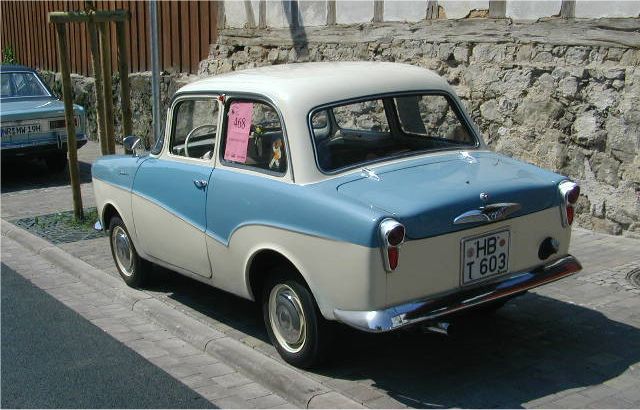Description
The Glas Isar T 700 was the larger and more powerful version of the Isar line of compact family cars produced by Hans Glas GmbH between 1959 and 1965. It followed the Isar T 600 and was developed to offer a bit more performance and refinement, making it more competitive with rivals such as the Volkswagen Beetle and BMW 700. For Glas, the T 700 was an important step in moving away from its microcar origins with the Goggomobil and into the mainstream small-car market.
The exterior design of the Isar T 700 was virtually identical to that of the T 600. It came in two main body styles: a two-door saloon and an estate car known as the Isar Kombi. Both versions had a neat and modest look, with rounded lines, integrated headlamps, a simple grille, and restrained use of chrome trim. Though compact—just under 4 meters long—the T 700 had proportions that gave it the presence of a true family car rather than a microcar. The Kombi added useful cargo space, making it attractive to small businesses and families who needed more versatility.
Inside, the T 700 was straightforward and functional, in keeping with its market position as an affordable people’s car. It offered seating for four, with slightly more comfort and space than the earlier T 600, though rear legroom remained limited. The dashboard was minimal, with only essential instruments, but Glas improved the materials and finish over time, giving the car a more refined feel than its predecessor.
The most important difference was under the rear-mounted bonnet. The T 700 was fitted with a 688 cc air-cooled, flat-twin four-stroke engine that produced around 30 horsepower—significantly more than the 19 hp of the T 600. This extra power gave the T 700 a higher top speed of about 110 km/h (68 mph) and better acceleration, making it more capable on open roads and better suited for longer journeys. Power was delivered through a four-speed manual transmission, and the car retained its rear-engine, rear-wheel-drive layout. While still modest in performance, the T 700 was far more usable for families than the smaller-engined version.
On the road, the Isar T 700 offered light handling and excellent fuel economy, but like the T 600, it was not without quirks. The rear-engine layout gave it good traction, but also instability at higher speeds, and build quality could be inconsistent compared to rivals. Nevertheless, for drivers looking for an economical, modern small car, it filled an important niche in early 1960s Germany.
Production of the Isar T 700 continued until 1965, when Glas phased out the Isar line to concentrate on more advanced models like the Glas 1004 with its innovative overhead cam engine. By the end of its run, both the T 600 and T 700 had helped Glas establish itself as more than a microcar maker, even if they never reached the success of competitors such as Volkswagen.
Today, the Glas Isar T 700 is a rare sight, but it holds a special place in automotive history. It represents Glas’s determination to grow into a serious car manufacturer and the transitional period in Germany when microcar makers were evolving toward conventional automobiles. Collectors value surviving examples for their historical significance, their simplicity, and their charm as one of the few small rear-engined cars produced outside of Volkswagen and BMW in that era.

